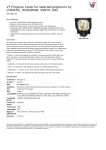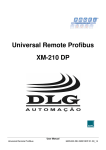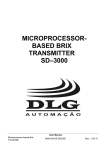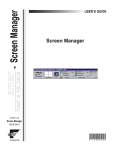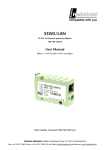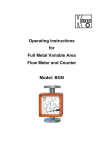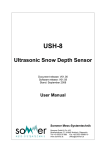Download Profibus/Modbus Gateway LMP-100
Transcript
Profibus/Modbus Gateway LMP-100 User Manual Profibus/Modbus Gateway MAN-EN-DE-LMP100-01.00_14 Introduction Thank you for choosing our Profibus/Modbus Gateway LMP-100. To ensure its proper and efficient usage, it’s important to read this manual thoroughly to understand how to operate the LMP-100, before putting it into operation. About this Manual 1. This manual should be delivered to the end user of the LMP-100. 2. The contents of this manual are subject to change without notice. 3. All rights reserved. No part of this manual may be reproduced in any form without the written permission from DLG. 4. The specifications contained herein are limited to standard models and do not cover special products made by order. 5. All precautions were taken on preparing this manual, in order to guarantee the quality of its information. CAUTION! The instrument described in this technical user manual is a device suitable for application in a specialized technical area. DLG supplied products are submitted to a strict quality control process. However, industrial control electronic equipment can cause damage to machinery or processes controlled by them in the event of any failure or improper operations and may even endanger human lives. The user is responsible for setting and selecting values of the parameters of the instrument. The manufacturer warns of the risks of incidents with injuries to both people and goods, resulting from the incorrect use of the instrument. Contents PRESENTATION .................................................................................................. 5 HOW TO SPECIFY ............................................................................................... 6 TYPICAL APPLICATIONS ................................................................................... 7 TECHNICAL SPECIFICATIONS ........................................................................... 8 General Characteristics ....................................................................................................... 8 DIMENSIONS ....................................................................................................... 9 FRONTAL ........................................................................................................... 10 CONFIGURATION .............................................................................................. 11 Profibus address configuration .......................................................................................... 11 GSD file installation ........................................................................................................... 12 Module configuration (LMP-100/M) ................................................................................... 12 Modbus network configuration ........................................................................................... 13 Modbus rule configuration ................................................................................................. 16 Diagnostics ........................................................................................................................ 23 Control register .................................................................................................................. 28 ELECTRICAL INSTALLATION .......................................................................... 32 Power Supply .................................................................................................................... 33 Profibus DP Communications ............................................................................................ 33 Modbus RTU Communications .......................................................................................... 33 MECHANICAL INSTALLATION ......................................................................... 34 RECOMMENDATIONS ....................................................................................... 35 WARRANTY ....................................................................................................... 36 LMP-100 PROFIBUS/MODBUS GATEWAY Presentation The LMP-100 is a gateway that enables the integration of the Profibus and Modbus industrial networks. By assuming simultaneously the role of a Profibus DP slave and a Modbus RTU master, it allows Modbus slaves to be controlled by Profibus masters. The LMP-100 may be mounted on a standard 35 mm DIN rail. LEDs provide indication of power supply, device, Modbus and Profibus network states. The power and communication cables are connected by fully detachable terminal blocks. The connection to the Profibus network can also be made through a DB9 connector on the frontal. LMP-100 User Manual MAN-EN-DE-LMP100-01.00_14 All rights reserved to DLG Automação Industrial © 2011 – 2014 Page 5 of 40 LMP-100 PROFIBUS/MODBUS GATEWAY How to Specify LMP-100 / ____ Profibus input and output buffers sizing: /compact: fixed size buffers /M modular: buffer sizing Page 6 of 40 LMP-100 User Manual MAN-EN-DE-LMP100-01.00_14 All rights reserved to DLG Automação Industrial © 2011 – 2014 LMP-100 PROFIBUS/MODBUS GATEWAY Typical Applications The LMP-100 is typically used in applications where Modbus slaves need to be integrated into a Profibus DP network. As an example, this scenario may occur in the following situations: • Replacement of a Modbus-based installation with a Profibus-based one, reusing the Modbus devices. • Necessity of using a particular device only available with Modbus communication in Profibus-based facility. Figure 1 depicts a LMP-100 typical application. In the role of a Profibus DP slave, the LMP-100 receives commands from the Profibus master. These commands are interpreted by the LMP-100 which, in the role of a Modbus master, forwards them to the Modbus slaves. Similarly, the LMP-100 periodically scans the Modbus slaves for field data, which are interpreted and sent to the Profibus master. The mapping between Profibus and Modbus inputs and outputs is configurable through a concept called “Modbus rule”. Figure 1 - LMP-100 application. LMP-100 User Manual MAN-EN-DE-LMP100-01.00_14 All rights reserved to DLG Automação Industrial © 2011 – 2014 Page 7 of 40 LMP-100 PROFIBUS/MODBUS GATEWAY Technical Specifications General Characteristics Type Notes Communication Profibus DPV0 and Modbus RTU, both over RS-485 Isolation Galvanic Profibus: 9.6k, 19.2k, 45.45k, 93.75k, 187.5k, 500k,1.5M,3M ,6M e 12M Modbus: 1.2k, 2.4k, 4.8k, 9.6k, 19.2k, 38.4k, 57.6k e 115.2k -10 ºC a 60 ºC -40 ºC a 70 ºC Up to 90% IP-30 (DIN EN 60529 VDE 0470) 20.4 - 28.8 Vdc 90 mA ABS plastic and flame resistant polycarbonate DIN 35 mm rail (DIN EN 60715 TH35) Cable up to 2.5mm² with “plug-in” type removable connectors 0,2 kg 101 x 22.5 x 119.5 mm. (height x width x depth – without frontal DB9 connector) Baud rates Operating temperature Storage temperature Relative humidity IP protection Input voltage Current consumption Construction Placement Electrical connection Aprox. weight Dimensions Page 8 of 40 LMP-100 User Manual MAN-EN-DE-LMP100-01.00_14 All rights reserved to DLG Automação Industrial © 2011 – 2014 LMP-100 PROFIBUS/MODBUS GATEWAY Dimensions Figure 2 – Dimensioning for assembling (dimensions in millimeters) LMP-100 User Manual MAN-EN-DE-LMP100-01.00_14 All rights reserved to DLG Automação Industrial © 2011 – 2014 Page 9 of 40 LMP-100 PROFIBUS/MODBUS GATEWAY Frontal LED Color PWR Green RUN Green BF Red ST Red TX RX Orange Green Page 10 of 40 Description (Power) Indicates power supply operation. Continuously lit LED indicates proper power supply operation. (Run) Indicates proper operation of the device. After the device is energized, the LED will flash 5 times. If the self-test boot routines succeed, the LED remains lit, indicating proper operation of the device. If the LED is turned off, a critical error occurred at startup, and in this case the device will no longer operate correctly. (Bus Fail) Indicates failure in the Profibus network. When lit means that the LMP-100 is not in the “Data Exchange” state. (Status) Indicates presence of failure or diagnostics. The failure is indicated by the frequency at which the LED flashes. When lit continuously, indicates the presence of diagnostic information. Indicates data transmission over the Modbus network. Indicates data reception over the Modbus network. LMP-100 User Manual MAN-EN-DE-LMP100-01.00_14 All rights reserved to DLG Automação Industrial © 2011 – 2014 LMP-100 PROFIBUS/MODBUS GATEWAY Configuration The LMP-100 was designed so that its entire configuration is obtained through the Profibus master. Thus, the configuration process is simplified by eliminating the use of additional tools. The only parameter that is not configurable through the master is the LMP-100 address on the Profibus network. It is important to notice that as all configuration is sent to the LMP-100 at the Profibus DP parameterization state, configuration changes cause the device to leave the data exchange state and return to the parameterization state, temporarily stopping the data transfer between the Profibus and Modbus networks. Note: Whenever functionality of bits grouped into one byte is described, consider bit 0 as the least significant bit and bit 7 as the most significant bit. Profibus address configuration The configuration of the LMP-100 Profibus address is accomplished through the selector switches located on the side of the device labeled “PROFIBUS ADDRESS”. There are seven selector switches, which enable the encoding of a binary number between 0 and 127, representing the device Profibus address. The device must be assigned an address between 1 and 126, as addresses 0 and 127 are reserved. The selector switches are numbered from 1 to 7. Switch 1 is the address least significant bit, and switch 7 is most significant one. As an example, to assign address 23 to the device, simply convert decimal number 23 into a 7-bit binary number: 2310 = 00101112 As the most significant bit is represented by switch number 7, the selector switches would have to be configured as: Switch 1 => ON Switch 2 => ON Switch 3 => ON Switch 4 => OFF Switch 5 = > ON Switch 6 => OFF Switch 7 => OFF LMP-100 User Manual MAN-EN-DE-LMP100-01.00_14 All rights reserved to DLG Automação Industrial © 2011 – 2014 Page 11 of 40 LMP-100 PROFIBUS/MODBUS GATEWAY The device reads the position of the selector switches immediately after being energized. The assigned address is kept constant during device operation, even if the position of the selector switches is changed. Therefore, to change the device’s Profibus address it is necessary to change the position of the selector switches to encode the new address, turn off and re-energize the device. GSD file installation The GSD (General Station Description) file supplied with the LMP-100 details all the features and characteristics of the device. The file must be installed within the Profibus master configuration software. The GSD file installation procedure is manufacturer specific, so it is recommended to consult the respective Profibus master user manual. After proper installation of the GSD file, the entire configuration of the LMP-100 is done through the Profibus master configuration software. For the compact version of the device, use the DLG_0D8A.gsd file. For the modular version of the equipment (/M), use the DLG_0E6C.gsd file. Module configuration (LMP-100/M) The LMP-100 modular option gives the user the power to size appropriately the number of bytes transferred in the Profibus input and output buffers. The GSD file defines input and output modules of several sizes which are handled by users in the Profibus master configuration tool. The following modules are available: 1 word input 1 word output 2 words input 2 words output 4 words input 4 words output 1 word = 2 bytes 8 words input 8 words output 16 words input 16 words output Modules must be allocated so that the Profibus input and output buffers have enough space to store data produced by the Modbus rules. The Modbus rule concept and how to calculate the amount of data produced by them are described in the “Modbus rule configuration” section. Page 12 of 40 LMP-100 User Manual MAN-EN-DE-LMP100-01.00_14 All rights reserved to DLG Automação Industrial © 2011 – 2014 LMP-100 PROFIBUS/MODBUS GATEWAY Modbus network configuration The LMP-100 provides the following configuration parameters for the Modbus network: Parameter Modbus baud rate Modbus parity Description Modbus network baud rate. All slaves must use the baud rate adopted by the LMP-100. The possible values are: • 1200 bps • 2400 bps • 4800 bps • 9600 bps • 19200 bps • 38400 bps • 57600 bps • 115200 bps Used as a mechanism to detect data transmission errors. All slaves must use the parity adopted by the LMP-100. For firmware versions up to 02.00.00, possible values are: • Even • Odd • None Starting from firmware version 02.01.00, possible values are: • Even • Odd • None with 1 stop bit • None with 2 stop bits The possibility of choosing the number of stop bits is aimed at increasing interoperability with the widest possible range of Modbus slaves. The Modbus specification states that 2 stop bits per character shall be used when parity is not used. However, there are countless slaves on the market that operate with only 1 stop bit. Modbus scan time (ms) Period, in milliseconds, of the scanning cycle used to poll data from Modbus slaves. Allowed values lie in the range from 0 to 60000 ms. The scanning cycle period is defined as the minimum time LMP-100 User Manual MAN-EN-DE-LMP100-01.00_14 All rights reserved to DLG Automação Industrial © 2011 – 2014 Page 13 of 40 LMP-100 PROFIBUS/MODBUS GATEWAY between the start of consecutive Modbus scanning cycles. For example, assuming a period of 5000 ms the device ensures that the next scan cycle will start at least 5000 ms after the current scan cycle. Value 0 indicates that the next scan cycle should begin immediately after the end of the current scan cycle. Modbus response timeout (ms) Factors such as number of variables, timeouts and retransmissions can cause the total time taken to scan all variables to be greater than the configured scan cycle period. In this case, the next scan cycle start immediately after the end of the current scan cycle. Maximum time in milliseconds that the LMP-100 waits to receive a response from a Modbus slave. If the slave does not respond within this time, the LMP-100 considers it as a failure and resends the command. Allowed values lie in the range from 10 to 60000 ms. Number of retransmission attempts of a command. Retransmissions occur when the slave does not respond or when the slave sends an incorrect response. Allowed values lie in the range from 0 to 5. Modbus retries Value 0 indicates no retries. Time waited by the LMP-100 to send a new command after receiving a response from a Modbus slave. Modbus interframe silence The possible values are: • 0 ms • 10 ms • 100 ms • 500 ms • 1000 ms The wait interval is useful to allow the slave which sent the response to be able to change the RS-485 transceiver direction from “transmit” to “receive”. The LMP-100 is configured by default to wait for 10 ms, a suitable value for most installations. Therefore, change this parameter only when really necessary. Table 1 – Modbus network parameterization Page 14 of 40 LMP-100 User Manual MAN-EN-DE-LMP100-01.00_14 All rights reserved to DLG Automação Industrial © 2011 – 2014 LMP-100 PROFIBUS/MODBUS GATEWAY Note: Except for the Modbus parity, all the parameters listed above have a direct influence on the time interval needed by the LMP-100 to scan all Modbus slaves. LMP-100 User Manual MAN-EN-DE-LMP100-01.00_14 All rights reserved to DLG Automação Industrial © 2011 – 2014 Page 15 of 40 LMP-100 PROFIBUS/MODBUS GATEWAY Modbus rule configuration The LMP-100 defines a concept named “Modbus rule”. Modbus rules define how to access Modbus variables that will be transferred to the Profibus network. A rule allows the definition of which Modbus variables should be mapped. A rule is classified as input rule or output rule. Input rules allow Modbus variables to be read and sent to the Profibus master. Output rules allow Modbus variables to be written with data sent by the Profibus master. The LMP-100 provides 38 Modbus rules, freely distributed between input and output rules according to the necessity. Rules are numbered R01, R02, ..., up to R32 (or 38 in the compact version). It is essential to understand how Modbus rules are related to the Profibus buffers in order to operate the device correctly. The LMP-100 has two buffers, named input buffer and output buffer, each 244 bytes long, used for data exchange with the Profibus master. The input buffer is where the LMP-100 puts data to be transferred to the Profibus master. This data is polled from the Modbus slaves. The output buffer is where the LMP-100 places data received from the Profibus master. This data will be transferred to the Modbus slaves. In the LMP-100 compact option, input and output buffers have a fixed length of 244 bytes. In the modular option, the user is allow to size the input and output buffers by inserting modules in the configuration. Input rules produce and store data in the input buffer. Assuming an input rule R01, for example, which specifies reading of 5 Modbus registers, and remembering that a Modbus register is 2 bytes long it is easy to deduce that the rule produces 10 bytes. Therefore, 10 bytes from the input buffer stores the value of the 5 Modbus registers read. Still as another example, rule R12 specifies reading of 7 Modbus digital inputs. As Modbus encodes up to 8 digital inputs in a byte, this rule will produce 1 byte, also copied to the Profibus input buffer. Besides computing the total number of bytes produced by an input rule, the only question remaining is the order in which data is stored in the input buffer. The LMP-100 calculates and reserves space in the input buffer according to the ascending order of the rules. Therefore, starting at R01, the LMP-100 checks whether R01 is an input rule. If so, the LMP-100 computes the number of bytes reserved to map R01, and allocates them in the beginning of the input buffer. The potential input rules are allocated sequentially in the input buffer. The process is repeated up to R38. The procedure is analog for output rules. The computation of the byte total and evaluation order of the rules are the same. Page 16 of 40 LMP-100 User Manual MAN-EN-DE-LMP100-01.00_14 All rights reserved to DLG Automação Industrial © 2011 – 2014 LMP-100 PROFIBUS/MODBUS GATEWAY A Modbus rule is configured through the following parameters: Parameter Description Modbus function used to read or write Modbus variables. Determines whether the rule is an input or output rule. • None: the rule is not executed and does not reserve space in the Profibus buffers. • Read Coils: allows reading of one or more digital outputs (coil). The rule becomes an input rule. • Read Discrete Inputs: allows reading of one or more digital inputs. The rule becomes an output rule. • Read Holding Registers: allows reading of one or more analog outputs. The rule becomes an output rule. Modbus function code • Read Input Registers: allows reading of one or more analog inputs. The rule becomes an input rule. • Write Single Coil: allows writing of one digital output. The rule becomes an output rule. • Write Single Register: allows writing of one analog output. The rule becomes an output rule. • Write Multiple Coils: allows writing of one or more digital outputs. The rule becomes an output rule. Modbus slave address Start address Number of variables • Write Multiple Registers: allows writing of one or more analog outputs. The rule becomes an output rule. Modbus slave addressed by the rule. Slaves in the range from 1 to 247 can be addressed. Together, these two parameters indicate which Modbus variables are addressed by the rule. The variables of one rule must be accessed contiguously. For example, one rule is able to read analog inputs with addresses 1 to 10. If it is necessary to read analog inputs 1 to 10 and 15 to 20, at least two rules are required. According to the Modbus specification, each data type (digital input, digital output, analog input and analog output) can have up to 65536 variables. LMP-100 User Manual MAN-EN-DE-LMP100-01.00_14 All rights reserved to DLG Automação Industrial © 2011 – 2014 Page 17 of 40 LMP-100 PROFIBUS/MODBUS GATEWAY The “Start Address” parameter determines the start address of the range of variables. The parameter “Number of variables” indicates how many variables will be accessed starting from the initial address. The “Start address” parameter accepts values in the range from 1 to 65535. The “Number of variables” in conjunction with the Modbus function selected in the “Modbus function code” parameter determines the byte count allocated in the Profibus buffers for the rule. Moreover, the range of allowed values for the “Number of variables” parameter depends on the type of variables accessed. The table below details the mentioned dependencies. Modbus function code Read Coils Read Discrete Inputs Write Multiple Coils Read Holding Registers Read Input Registers Write Multiple Registers Write Single Coil Write Single Register Number of variables (n) Number of bytes reserved 1 ≤ n ≤1952 (n – 1) / 8 + 1 1 ≤ n ≤122 n*2 Parameter is not used 2 Since the maximum value of the “Start address” parameter is 65535, to access variable 65536 a rule with “Start address” less than or equal to 65535 and “Number of variables” large enough to address variable 65536 must be created. As examples: Number of variables 65535 2 65530 7 Addressed variables 65535 65536 65530 65531 65532 65533 65534 65535 65536 Defines whether the input (Input Registers) or output (Holding Registers) byte order should be inverted. Byte swap (available starting at firmware version 02.01.00) Page 18 of 40 Start Address • No: byte order is not inverted. • Yes: byte order is inverted. LMP-100 User Manual MAN-EN-DE-LMP100-01.00_14 All rights reserved to DLG Automação Industrial © 2011 – 2014 LMP-100 PROFIBUS/MODBUS GATEWAY On variables that require more than 1 byte of storage, the definition of the byte order is essential for the correct processing of the variable. There are two possible byte orders considering that a Modbus analog variable is 2 bytes long: • Little endian (LE), also known as Intel format. • Big endian (BE), also known as Motorola format. The LE order dictates that the variable’s least significant byte must be stored in the memory address right before the memory address of the most significant byte. In BE order, the byte positions are inverted. Equipments with Modbus communications shall encode their analog variables in the BE format. Therefore, the analog data acquired by the LMP-100 is encoded in this format. Profibus masters and other supervisory systems may be designed to operate in the LE format. Should that be the case, the LMP-100 may be configured to perform the byte order inversion internally, thus eliminating the need to program a byte order inversion algorithm in the PLC, for instance. When configured to perform the byte order inversion, the LMP100 inverts the input variables before copying them to the Profibus input buffer, as well as the ouput variables before sending them to the proper Modbus slave. It is worth noting that the LMP-100 inverts all variables of a rule configure to acquire more than one variable. Defines the behavior of output rules. This parameter is ignored when the rule is an input rule. • Every scan cycle: output rules produce an automatic Modbus write command on each scan cycle. The written value is the last value received from the Profibus master. Write trigger • On value change: output rules produce an automatic Modbus write command only when the value sent by the Profibus master is different from the last value written to Modbus slave. • User triggered: output rules produce a Modbus write command only when requested by the control register. LMP-100 User Manual MAN-EN-DE-LMP100-01.00_14 All rights reserved to DLG Automação Industrial © 2011 – 2014 Page 19 of 40 LMP-100 PROFIBUS/MODBUS GATEWAY Choosing between the three available behaviors requires understanding of the specific application. The behavior “On value change” is optimal from the Modbus network standpoint, since data writing occurs only when the Profibus master sends a different value. However, this behavior is only totally safe when the variable to be written is retentive, i.e., it holds the last value even if the Modbus slave is turned off and on again. This caution is justified by the following example: an output rule is configured with the behavior “On value change”. At one point in time, the Profibus master changes the value of a digital output from 0 to 1. The LMP-100 transfers this change to the appropriate Modbus slave. Sub sequentially, the Modbus slave is turned off and on again, and the non-retentive digital output goes back to value 0. In this situation, the Profibus master keeps sending value 1, but as the value has not changed, the LMP-100 does not detect change and does not forward the current value to the Modbus slave. This situation was caused by the digital output changing from 1 to 0 when the device was turned off. The “User triggered” behavior allows the user to control exactly at which time writing is made. The control register allows the user to trigger each output rule individually, writing the value available in the Profibus output buffer. Therefore, output rules with the “User triggered” behavior need the value to be written copied to the Profibus output buffer and the trigger fired in the control register. The writes triggered by the LMP-100 always carry all the variables addressed by the rule. An output rule addressing, for instance, five Modbus variables configured with behavior “On value change” and that at a given time detects the change of only one of the five variables will result in a Modbus write command containing the new value of the variable that has changed and the last value of the other variables. Sets whether the rule is enabled or disabled. A disabled rule does not produce activity in the Modbus network. Enabled • Yes: the rule is enabled. • No: the rule is disabled. In some cases it may be interesting to disable a rule. For example, a defective Modbus slave can cause considerable Page 20 of 40 LMP-100 User Manual MAN-EN-DE-LMP100-01.00_14 All rights reserved to DLG Automação Industrial © 2011 – 2014 LMP-100 PROFIBUS/MODBUS GATEWAY delays in the LMP-100 scanning cycle, due to communication timeouts. In this case, it is suggested to disable the rules that address the faulty slave. Even not producing activity in the Modbus network, a disabled rule keeps its space reserved in the Profibus buffers. Thus, the relative position of data in the buffers for each rule is unchanged, avoiding reconfigurations in the Profibus master data access. A rule can also be disabled by changing the parameter “Modbus function code” to “None”. However, this option is NOT recommended because it changes the relative position of data in the Profibus buffers. Thus, the Profibus master will have to be reconfigured to readjust data access in the buffers. Table 2 – Modbus rule parameterization It is important to know how the Modbus functions encode the data exchanged between masters and slaves, since the LMP-100 transfers to the Profibus buffers Modbus data exactly as they are exchanged in the Modbus network. Table 3 details how data is encoded according to each Modbus function. Modbus function Read Coils Read Discrete Inputs Write Multiple Coils Encoding Each variable is encoded as 1 bit. Data is always transferred in multiples of 1 byte. The least significant bit of the first byte contains the variable address by the parameter “Start address”. The following variables will be encoded toward the most significant bit. When 8 variables fill the byte, a new byte is allocated, keeping the encoding from the least to the most significant bit. When there are unused bits in a byte, the bit is set to 0. As an example, the digital input variables 5 to 16 are encoded as shown below. 12 b7 11 b6 10 b5 9 8 b4 b3 byte 1 7 b2 6 b1 5 b0 b7 b6 b5 16 b4 b3 byte 2 15 b2 14 b1 13 b0 The first byte stores the value of variables 5 to 12, and the second byte stores the value of variables 13 to 16. In the second byte, bits b4, b5, b6 and b7 are set to 0 because they are unused. Read Input Registers Read Holding Registers Each variable is encoded as 2 bytes, using “big endian” byte order. As an example, two analog inputs with addresses 10 and 11 and values 300 and 10000 are encoded as follows: LMP-100 User Manual MAN-EN-DE-LMP100-01.00_14 All rights reserved to DLG Automação Industrial © 2011 – 2014 Page 21 of 40 LMP-100 PROFIBUS/MODBUS GATEWAY Write Single Register Write Multiple Registers 01 MSB 2C LSB 27 MSB byte 1 Variable 10 10 LSB byte 2 Variable 11 MSB is the most significant byte; LSB is the least significant byte. Variable values are represented in hexadecimal notation: 30010 = 012C16 1000010 = 271016 The value to be written to the digital output is encoded in two bytes. Write Single Coil To write 0 to the output, it is necessary to transfer the value 000016. To write 1 to the output, it is necessary to transfer the value FF0016. Table 3 – Modbus variables encoding Page 22 of 40 LMP-100 User Manual MAN-EN-DE-LMP100-01.00_14 All rights reserved to DLG Automação Industrial © 2011 – 2014 LMP-100 PROFIBUS/MODBUS GATEWAY Diagnostics The LMP-100 provides diagnostic information, describing in detail its operation status. The diagnostic information is encoded in 42 bytes, as shown below. byte 0 Diagnostic byte count bytes 1 and 2 Reserved byte 3 Operation diagnostics byte 4 Rule R01 diagnostics ... ... byte 41 Rule R38 diagnostics Diagnostic is comprised of several conditions mapped into bits, where bits with value 1 indicate an alarmed condition. Byte 0 indicates the number of available diagnostic bytes. The LMP-100 provides 42 diagnostic bytes. Bytes 1 and 2 are reserved. Byte 3 contains the Modbus rules overall diagnostics, encoded as shown in table 5. Byte Bit 0 1 2 3 4 5 Condition Reserved Reserved Reserved Reserved Reserved Exception in Modbus response Description While processing the Modbus rules, at least one slave returned a response with an exception. 3 6 Timeout in Modbus response 7 Error in Modbus response While processing the Modbus rules, at least one slave did not return a response within the time period specified by the “Modbus response timeout” parameter. While processing the Modbus rules, at least one slave returned a response Comments The LMP-100 remains in operation. It is possible to check which slaves produced the exception by checking the rule specific diagnostics. The LMP-100 remains in operation. It is possible to check which slaves produced the exception by checking the rule specific diagnostics. The LMP-100 remains in operation. It is possible to check LMP-100 User Manual MAN-EN-DE-LMP100-01.00_14 All rights reserved to DLG Automação Industrial © 2011 – 2014 Page 23 of 40 LMP-100 PROFIBUS/MODBUS GATEWAY with an error. Errors may be parity errors, incomplete responses, among others. which slaves produced the exception by checking the rule specific diagnostics. Table 4 – Operation diagnostics Bytes 4 to 41 contain detailed diagnostics of Modbus rules R01 to R38, respectively. Information is encoded as shown below. Byte Bit Condition 0 Reserved Description Exception in Modbus response While processing the rule, the slave returned a response with an exception. Timeout in Modbus response While processing the rule, the slave did not return a response within the time period specified by the “Modbus response timeout” parameter. 3 Error in Modbus response While processing the rule, the slave returned a response with an error. Errors may be parity errors, incomplete responses, among others. 4 5 6 7 Reserved Reserved Reserved Reserved 1 2 4 – 41 Comments The LMP-100 remains in operation. The rule will be processed in the next cycle, and the diagnostic condition remains active while the slave responds with an exception. The LMP-100 remains in operation. New transmission attempts will be made, and the diagnostic condition remains active while the slave does not respond. The LMP-100 remains in operation. The rule will be processed in the next cycle, and the diagnostic condition remains active while the slave responds with an error. Table 5 – Modbus rule diagnostics Diagnostic data can be obtained through two mechanisms. The choice of mechanism is done via the “Device diagnostics” parameter. The options are: Page 24 of 40 LMP-100 User Manual MAN-EN-DE-LMP100-01.00_14 All rights reserved to DLG Automação Industrial © 2011 – 2014 LMP-100 PROFIBUS/MODBUS GATEWAY Parameter Profibus input Profibus extended diagnostics No diagnostics Description Diagnostic data is transferred to the start of the Profibus input buffer. Thus, the Profibus master accesses diagnostic data in the same way that it accesses Modbus input data. The Modbus input data produced by the Modbus rules are placed right after the diagnostic data. Diagnostic data is transferred to the Profibus master via a Profibus protocol functionality named extended diagnostics. None of the previous mechanisms is used. Thus, there is no way the user can get diagnostic data. (available starting at firmware version 02.01.00) The LMP-100 provides exactly the same diagnostic data for both mechanisms. The choice of mechanism for accessing diagnostic data must take into account certain factors. The “Profibus input” option lets diagnostic data to be accessed easily, since they are mapped to the Profibus input buffer. However, as they are mapped to the the input buffer, they take space in the buffer, reducing the number of Modbus input variables that can be mapped through the rules. The “Profibus extended diagnostics” option does not make use of the input buffer to send diagnostic data, taking advantage of the Profibus extended diagnostics functionality. Thus, the entire input buffer can be used to access Modbus input variables. However, the Profibus master configuration required to access the extended diagnostic data is usually more difficult than the configuration to access data from the input buffer. In addition, some Profibus masters simply do not allow the user to access extended diagnostics. Looking at the factors mentioned above, the decision on which diagnostics mechanism to be chosen is weighted by the effort required to access the data, the possibility of reserving part of the input buffer for diagnostic data, and also by the extended diagnostic data access in the chosen Profibus master. The ST (Status) LED is lit when at least one diagnostic condition is alarmed. When all conditions return to normal, the ST LED turns off. Even if the user chooses not to access diagnostic data, through the “No diagnostics” option, the ST LED keeps indicating diagnostic conditions. In addition to diagnostic conditions, the ST LED is also used to indicate device failure. Failures cause the device to stop operating. In such cases, the device automatically reboots every 10 seconds in an attempt to recover. The failure is identified by the frequency with which the ST LED flashes. While in failure conditions, the ST LED alternates between a minor cycle in which it blinks rapidly and large cycle when it is turned off. The number of times the LED blinks in the minor cycle indicates the specific failure. The RUN LED turns off while the device is in failure conditions. The table below shows the possible failures, how to identify them and the possible recovery options. LMP-100 User Manual MAN-EN-DE-LMP100-01.00_14 All rights reserved to DLG Automação Industrial © 2011 – 2014 Page 25 of 40 LMP-100 PROFIBUS/MODBUS GATEWAY Page 26 of 40 LMP-100 User Manual MAN-EN-DE-LMP100-01.00_14 All rights reserved to DLG Automação Industrial © 2011 – 2014 LMP-100 PROFIBUS/MODBUS GATEWAY Identification by the ST LED ST LED blinks once in the minor cycle. Failure Memory test failure after the device is energized. ST LED blinks twice in the minor cycle. Invalid Profibus address. ST LED blinks three times in the minor cycle. ST LED blinks four times in the minor cycle. Illegal state in the Profibus state machine. Modbus communications layer initialization error. Insufficient number of bytes in the input or output buffers to store all data produced by the rules. Recovery Device goes into a reboot cycle. If the failure persists, the device has a hardware defect and must be replaced. Device goes into a reboot cycle. Set via the device selector switches a Profibus address between 1 and 126. Device will start operating normally after the next reboot and will be configured with a valid address. Device is automatically rebooted, going into normal operation. Device is automatically rebooted, going into normal operation. Device goes into a reboot cycle until the configuration is fixed properly. In the compact option of the LMP-100, check if the number of bytes produced by input or output rules does not exceed 244 bytes, considering that 42 input bytes are ST LED blinks five allocated if diagnostics is mapped to the times in the minor input buffer and that 16 output bytes are cycle. allocated for the control register. In the modular option of the LMP-100, check if the input and output buffer sizing is sufficient to store all data produced by the rules. Table 6 – Failure identification via the ST LED. LMP-100 User Manual MAN-EN-DE-LMP100-01.00_14 All rights reserved to DLG Automação Industrial © 2011 – 2014 Page 27 of 40 LMP-100 PROFIBUS/MODBUS GATEWAY Control register The LMP-100 provides the user with a data area called control register, where several settings can be performed on the device. The control register is located at the start of the Profibus output buffer, occupying the first 16 bytes. Therefore, to calculate the location of data consumed by the write rules it must be considered that data is arranged immediately after the control register, after byte 16. The control register contents are shown below. byte 0 Slave address byte 1 Slave activation control bytes 2 – 6 Write triggers bytes 7 – 15 Reserved Bytes 0 and 1 of the control register allow controlling the activation of Modbus slaves. Activation means the possibility of stopping and reestablishing communications with a Modbus slave while the LMP-100 is operating, without the need for Modbus rule reconfiguration. As explained before in the rule configuration section, each rule has a parameter called “Enabled”, with the purpose of avoiding that a the rule produces activity in the Modbus network. This parameter is interesting in situations such as failure or removal of a Modbus slave, which cause network timeouts due to rules that address the referred slave. The “Enabled” parameter can be set to value “No” in all rules that address the missing or defective Modbus slave, preventing Modbus communications with the slave. However, it is important to emphasize again that any change in the LMP-100 parameters stops data exchange while the the device is reparameterized by the Profibus master. The activation control in the control register is an option for situations where it is interesting to the interrupt communications with a Modbus slave without reparameterization of the LMP100. The LMP-100 treats as disabled the Modbus rules that address a deactivated Modbus slave. The rules remain disabled until slave reactivation is requested in the control register or until the equipment is reparameterized. When reparameterized the rule enabled state is a function solely of its “Enabled” parameter value. Byte 0 must be set with the address of the Modbus slave that will have its activation state changed. Byte 1 allows choosing if the slave will be activated or deactivated and also trigger the activation change. The byte encoding is shown below. Page 28 of 40 LMP-100 User Manual MAN-EN-DE-LMP100-01.00_14 All rights reserved to DLG Automação Industrial © 2011 – 2014 LMP-100 PROFIBUS/MODBUS GATEWAY Bit 0 1 2 3 4 5 Function Reserved Reserved Reserved Reserved Reserved Reserved Description A rising edge on the bit value triggers the activation state change of the Modbus slave referred in byte 0, i.e., the bit value must be changed from 0 to 1. Changing it from 1 to 0 does not trigger the activation change. Defines whether the Modbus slave is activated or deactivated when activation state change is triggered by bit 6. 6 Trigger 7 Activation 0: deactivates the slave 1: activates the slave Note: Activation of an active slave or deactivation of an inactive slave has no effect. Table 7 – Modbus slave activation control. The control register is also used to trigger write rules in which the parameter “Write trigger” is set to “User triggered”. As explained before in the rule configuration section, a user triggered rule gives the user complete control on when the write command is sent to the Modbus network. Bytes 2 to 6 of the control register are encoded in a way that each rule has a trigger bit. It is important to note that the trigger bits only results in Modbus writes if the rule is configured as user triggered. The other two write options (“Every scan cycle” and “On value change”) are not affected, since they handle writing in an automatic fashion. The table below details the byte encoding for write triggering. The write is triggered by a rising edge in the corresponding bit, i.e., changing its value from 0 to 1. Changing the bit value from 1 to 0 does not trigger writing. Byte 2 3 Bit 0 1 2 3 4 5 6 7 0 1 2 Description Rule R08 user trigger Rule R07 user trigger Rule R06 user trigger Rule R05 user trigger Rule R04 user trigger Rule R03 user trigger Rule R02 user trigger Rule R01 user trigger Rule R16 user trigger Rule R15 user trigger Rule R14 user trigger LMP-100 User Manual MAN-EN-DE-LMP100-01.00_14 All rights reserved to DLG Automação Industrial © 2011 – 2014 Page 29 of 40 LMP-100 PROFIBUS/MODBUS GATEWAY 3 4 5 6 7 0 1 2 3 4 5 6 7 0 1 2 3 4 5 6 7 0 1 2 3 4 5 6 7 4 5 6 Rule R13 user trigger Rule R12 user trigger Rule R11 user trigger Rule R10 user trigger Rule R09 user trigger Rule R24 user trigger Rule R23 user trigger Rule R22 user trigger Rule R21 user trigger Rule R20 user trigger Rule R19 user trigger Rule R18 user trigger Rule R17 user trigger Rule R32 user trigger Rule R31 user trigger Rule R30 user trigger Rule R29 user trigger Rule R28 user trigger Rule R27 user trigger Rule R26 user trigger Rule R25 user trigger Reserved Reserved Rule R38 user trigger Rule R37 user trigger Rule R36 user trigger Rule R35 user trigger Rule R34 user trigger Rule R33 user trigger Table 8 – User trigger control. Note: bytes 7 to 15 of the control register are reserved and have no effect on the device operation. If the user has no interest in using the functionality provided by the control register, it can be disabled via the “Control register” parameter. Parameter Control register Description Disables the control register functionality and do not reserve memory for it at the Profibus output buffer. (available starting at firmware version 02.01.00) Page 30 of 40 LMP-100 User Manual MAN-EN-DE-LMP100-01.00_14 All rights reserved to DLG Automação Industrial © 2011 – 2014 LMP-100 PROFIBUS/MODBUS GATEWAY It is important to be aware that by disabling the control register the user is no longer able to control the runtime activation of slaves and it becomes impossible to trigger user-triggered write rules. It is also important to note that the output buffer becomes fully available for Profibus output variables, since the control register is no longer mapped at the beginning of the output buffer. LMP-100 User Manual MAN-EN-DE-LMP100-01.00_14 All rights reserved to DLG Automação Industrial © 2011 – 2014 Page 31 of 40 LMP-100 PROFIBUS/MODBUS GATEWAY Electrical Installation Figure 3 – LMP-100 electrical connections. Attention: all cables must be “crimped” with eyelet terminals for cables up to 1.5 mm² unless otherwise stated. For the interconnection of communication signals it is recommended to use woven shielded cables and the woven grounding must be done on the S terminal and other ground references located at the bus extremities. Page 32 of 40 LMP-100 User Manual MAN-EN-DE-LMP100-01.00_14 All rights reserved to DLG Automação Industrial © 2011 – 2014 LMP-100 PROFIBUS/MODBUS GATEWAY Power Supply The LMP-100 must be powered through the + e – terminals with voltage in the range from 20.4 to 28.8 Vdc. The GND terminal is used to ground the “mass” to the panel. It is recommended to use 1,5mm² cables to the + and – terminals and 2,5mm² cables to the ground. The wiring diagram is described in the picture. Profibus DP Communications The LMP-100 provides a Profibus DP over RS-485 serial communication channel. Connections to this channel are made through terminals named positive (B), negative (A) and shield (S). Connection to the Profibus DP channel can also be made through the DB9 connector available on the LMP-100. The connection must be made using standard Profibus DP connectors. The DB9 connector and the terminals are internally wired, and can be used together. For example, the LMP-100 may be connected to the Profibus master through the terminals and a network analyzer can be simultaneously connected to the DB9 connector, without disturbing the device operation. Modbus RTU Communications The LMP-100 provides a Modbus RTU over RS-485 serial communication channel. Connections to this channel are made through terminals named positive (485+), negative (485-) and shield (S). LMP-100 User Manual MAN-EN-DE-LMP100-01.00_14 All rights reserved to DLG Automação Industrial © 2011 – 2014 Page 33 of 40 LMP-100 PROFIBUS/MODBUS GATEWAY Mechanical Installation Fix the LMP-100 on the the top of the DIN rail. Using a screwdriver, pull the lock that is located at the bottom of the LMP-100. After pulling the lock, fix the LMP-100 at the bottom of the DIN rail. Release the lock and make sure that the LMP100 is attached to the DIN rail. Page 34 of 40 LMP-100 User Manual MAN-EN-DE-LMP100-01.00_14 All rights reserved to DLG Automação Industrial © 2011 – 2014 LMP-100 PROFIBUS/MODBUS GATEWAY Recommendations It is recommended to use only appropriate tools for the LMP-100 installation and maintenance. It is necessary to use a “terminal” type screwdriver for terminal connection or 1/8 with 3 mm maximum diameter, as it is the ideal format and will not damage the connector aperture. It is recommended to crimp all the wires that will be connected to the LMP-100 with a pre-isolated “needle” type or “eyelet” type terminal for cables of 0,5 ~ 1,5 mm2. Inappropriate screwdriver Needle terminal LMP-100 User Manual MAN-EN-DE-LMP100-01.00_14 All rights reserved to DLG Automação Industrial © 2011 – 2014 Recommended screwdriver Eyelet terminal Page 35 of 40 LMP-100 PROFIBUS/MODBUS GATEWAY Warranty The manufacturer assures to the equipment owners, identified by the purchase invoice, warranty of 1 (one) year as follows: 1. The warranty period begins on the data of the invoice issue. 2. Within the warranty period, the labor and parts used for repairing damage occurred in normal use are free. 3. For repairs, send the equipment along with the shipping invoices to our factory in Sertaozinho, Sao Paulo state, Brazil. DLG’s address is available at the end of this manual. 4. The owner is responsible for transportation costs and risks. 5. Warranty will be automatically suspended if changed are made to the equipment by personnel not authorized by DLG, defects caused by mechanical shock, exposure to conditions unfit for use or tampering with the product. 6. DLG disclaims any charge relating to unauthorized repairs or replacements due to failures caused by agents external to the equipment, the improper use of them and as a result of unforeseeable circumstances or major forces. 7. DLG ensures full operation of the equipment described herein and all existing operations. Page 36 of 40 LMP-100 User Manual MAN-EN-DE-LMP100-01.00_14 All rights reserved to DLG Automação Industrial © 2011 – 2014 Notes DLG Automação Industrial Ltda. Rua José Batista Soares, 53 Distrito Industrial – 14176-119 Sertãozinho – São Paulo – Brasil Fone: +55 (16) 3513-7400 www.dlg.com.br MAN-EN-DE-LMP10001.00_14 GATEWAY PROFIBUS / MODBUS LMP-100 DLG reserves the right to change this manual contents without notice in order to keep it updated with future product improvements.








































